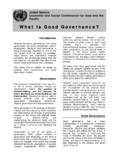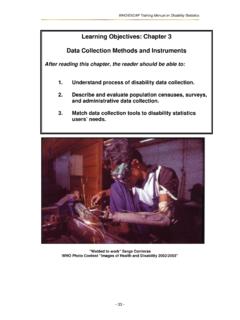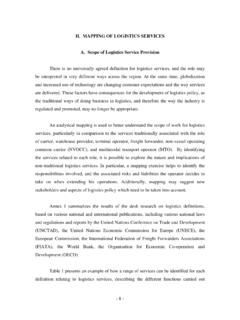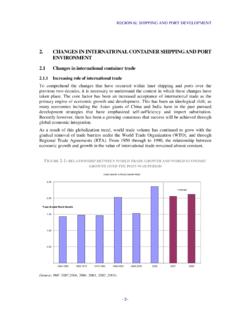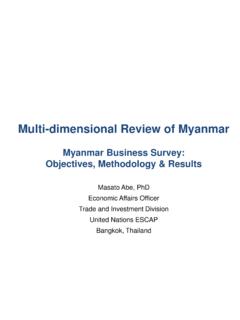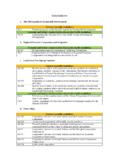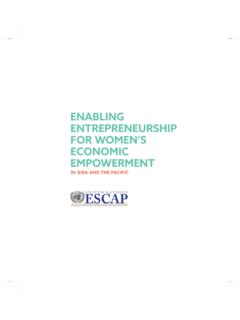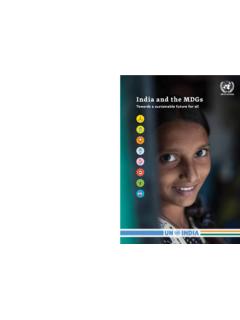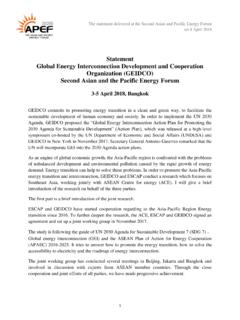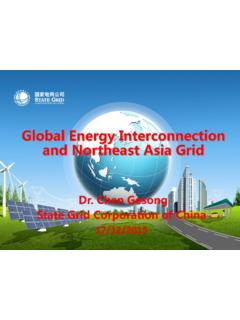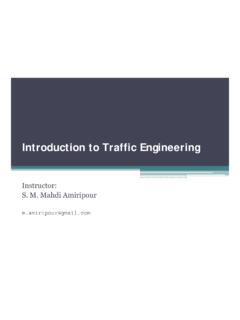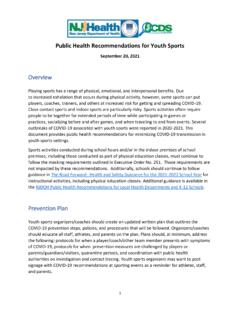Transcription of Concept of Sustainable Transport: Planning and Designing ...
1 UNESCAP Transport Division Concept of Sustainable Transport: Planning and Designing for Sustainable and Inclusive Transportation SystemsNational Capacity Building Workshop on Sustainable and Inclusive Transport DevelopmentColombo, Sri Lanka 9-10 July 2015 ContentWhat is the presentation about? Main Challenges Concept of Sustainable transport Long term vision for the development of the region s transport system Planning Sustainable transportSystem Strategies and Barriers Way forwardSustainable Transport Our Main ChallengesTransport vital for economic development and personal welfare, Difficult to meet growing demand (economic and population growth, rising income) faster than economies growing Growing energy consumption and other resources 15 20% or more of total import cost Air pollution, emission of GHGs growing faster than GDP Adverse health and social impacts outdoor air pollution contributed to 712,000 deaths in South Asia (GBD Study)
2 Road safety more than 2,800 road deaths in Sri Lanka in 2010 (WHO) Non inclusive development not all are benefitingCombined cost could be up to 10% of GDPC annot do business as usualSustainable Transport ConceptSustainable Development The development that meets the needs of the present without compromising the ability of future generations to meet their own needs (Brundtland Report) Three pillars: economic, social, and environmental Sustainable Transport ConceptMain current approaches Reduction of transport demand Promotion/improvement of more energy efficient and environment friendly transport modes Improvement in efficiency of the transport process Introduction of new technologyAvoidShiftImproveSustainable Transport Long-Term Vision An internationalintegrated intermodal transport and logistics system Endorsed by the Commission (2007 and 2012)
3 It is the system that has the intermodal network of well designed, maintained and interconnected highways, railways, inland waterways, sea ports, river ports, airports or dry ports that, through modal shift, optimizes the needs of transporting goods and passengers minimizes consumption of energy, land and other resources generates low emissions of, greenhouse gases and ozone depleting substances minimizes the adverse social impacts arising from transport operations. An internationalintegrated intermodal transport and logistics system The system combines the advantages of each mode of transport to achieve the balanced integration of economic, social and Transport Key FactorsEconomic Factors Cost Speed Capacity Flexibility ReliabilitySocial Factors Access Min.
4 Accident CongestionEnvironment Factors Energy Intensity Emission PollutionSustainable Transport Key FactorsEconomicAdvantages/DisadvantagesC ostper Ton-Mile (USD)Capacity(Truck Equivalent)SpeedReliabilityFlexibilityHi ghLowestModerateGoodHighLowHighModerateG oodLowLowestHighestSlowLimitedLowHighest LowVery HighVery goodMediumSustainable Transport Key FactorsEnvironmentAdvantages/Disadvantag esEnergy Intensity(BTU per ton mile)USA 2006CO2 Emission(per ton km)Europe 2011 Air Pollution*(Euro ct/tkm) 0 Diesel Transport Key Factors*Handbook on estimation of external costs in the transport sector (2008), Commissioned by European Commission DG TREN Sustainable Transport Example - FreightModal Shift Photos Credit SRTM odal shift from road to rail at Lat Krabang ICD Te r m i n a lVolume moved by Rail in May 2015.
5 38,026 TEUsWith Simple Calculation Appx5,000 tons of CO2 reduction/ month Cheaperoptions Free up at least 19,000 trucks along 118 km roads in that month less congestion at port(calculate using the average of dry container at appx 24 ton/TEUs)Lat Krabang ICD Te r m i n a lOne of the most developed and advanced dry port in Asia, developed on Concession in 199327 Km East of Bangkok, 118 Km from LaemChabang port (direct rail connection to port) Sustainable Transport Urban TransportSustainable Transport Urban TransportSustainable Transport Example Passenger Better and integrated public transport systems inclusive services Use of NMTs (including walking) Modal shiftPun Pun Bike sharing, BangkokPhoto credit: Ridwan QuaiumRajshahi, BangladeshSustainable Transport Example Passenger Photos Credit pun pun BKK Bicycle Share / member no.
6 2127723 at Motorized TransportBike Sharing SystemSky TrainSubwayMain strategies: Improved system operation (ITS application, integration of transport modes) Demand management ( staggered working hours) Economic instruments (tax, subsidy, pricing, etc) Regulatory standards (vehicle, fuel, maintenance) New technology (engine, vehicle, fuel, material etc) Sustainable Transport Efficiency in Transport Process Engine (emission control, direct injection etc) Vehicle (safety, fuel efficiency) Fuel (higher emission standard compatible) ICT/ITS (coordinated traffic signals, transit operation, management of toll roads, expressways) Infrastructure (pavement, material etc)
7 ITS, BangkokERP, SingaporeNew Technology bus, OttawaSustainable Transport TechnologySustainable Transport Potential BarriersInstitutional Barriers Planning and policy formulation non inclusive, technocratic Laws, regulations, rules not always supportive Coordinated action by different agencies difficulties in inter agency coordination Social and cultural barriers Car represent social status ? Resource barriers (including human resource) Sustainable Transport Potential BarriersPolicy and structural barriers Policy biases are common eg., favouring road sector in resource allocation, ignoring Sustainable development measures, needs of marginal and other groups ignored Policy distortions (eg.)
8 Energy pricing) fuel subsidy in some countries; inconsistent, contradictory policies across sectors Sector and market structure in transport eg, fragmented freight sector in most DCs, difficult to improve efficiency Regulatory institutions and performance standards may be either lacking or deficient Transport StrategiesSuggestions for consideration Inclusion of Sustainable transport (ST) in national development framework Formulation of an agreed national policy framework on ST (national and urban) Development of a framework of indicators and benchmarks for Planning and monitoring the progress in Sustainable transport development Institutionalization of integrated Planning , policy formulation and coordinationof action Creating a supportive environment ( R&D) Social awareness and education--Th nk @
